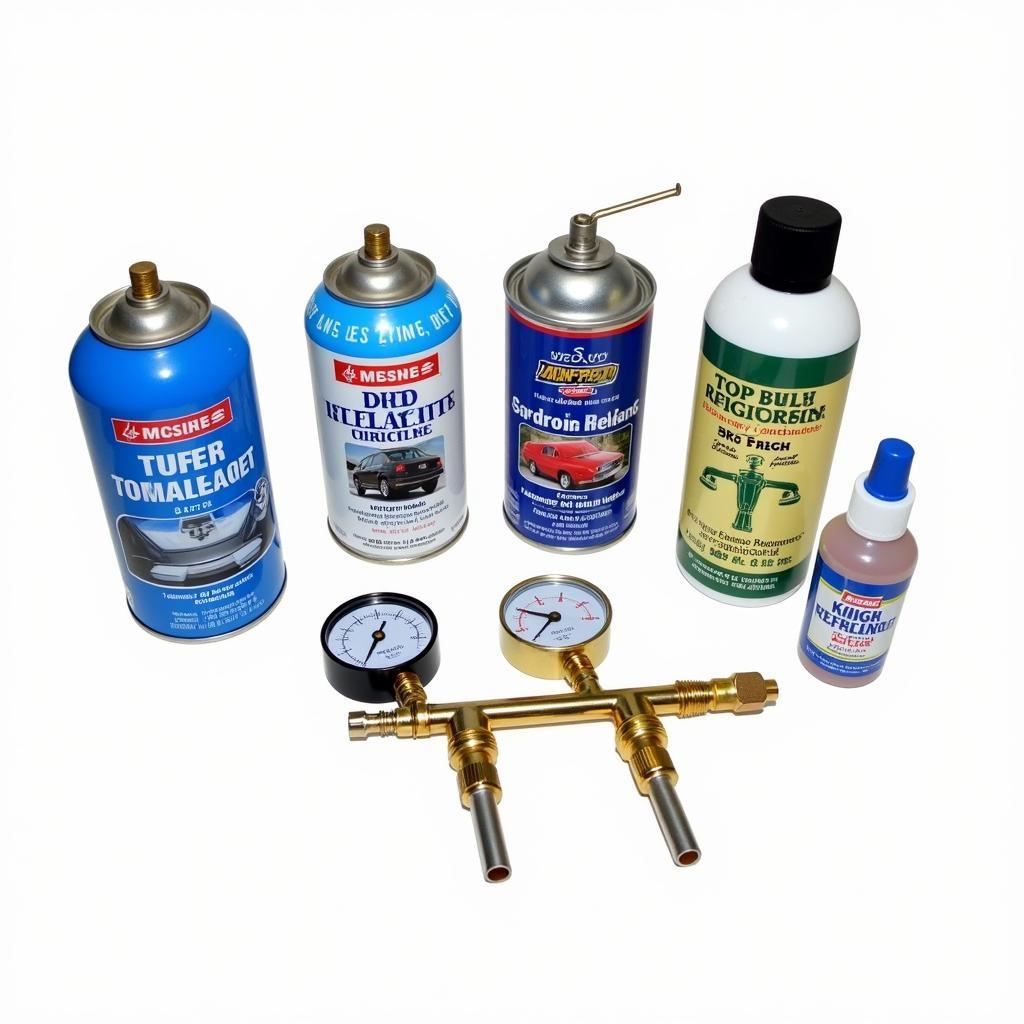If you’re looking for the name of the tool used to put freon in a car, you’ve come to the right place. This guide will explore everything you need to know about recharging your car’s AC system, from the tools involved to safety precautions. We’ll delve into the specific tool, often called an AC manifold gauge set, and how it plays a critical role in this process.
Understanding the AC Manifold Gauge Set
The primary tool used to put freon, or more accurately, refrigerant, in a car is an AC manifold gauge set. This crucial piece of equipment allows technicians and DIYers to measure the pressure of the refrigerant in the system, identify leaks, and accurately recharge the AC. Without a manifold gauge set, recharging your AC system would be like driving blindfolded – dangerous and ineffective.
Why is an AC Manifold Gauge Set Important?
An AC manifold gauge set isn’t just about putting refrigerant into the system. It’s about doing it safely and correctly. Overcharging can damage your compressor, while undercharging will leave you sweating. The gauges provide the necessary feedback to ensure the optimal refrigerant charge. They also help diagnose issues like blockages and leaks, allowing you to address the root cause of the problem.
How to Use an AC Manifold Gauge Set
Using a manifold gauge set requires some technical knowledge. It’s not as simple as just connecting it and adding refrigerant. You need to understand the readings, the different types of refrigerants, and the specific requirements of your car’s AC system. Always consult your car’s owner’s manual for specific instructions and safety precautions.
Connecting the Gauges
The manifold gauge set has two hoses: a high-pressure side (red) and a low-pressure side (blue). These connect to the corresponding ports on your car’s AC system. Before connecting, ensure the system is off and the refrigerant is properly identified.
Reading the Gauges
The gauges display the pressure in both the high and low sides of the system. These readings are crucial for determining the correct refrigerant charge. Consult a pressure-temperature chart specific to your refrigerant type to determine the ideal pressure for the ambient temperature.
 Technician using an AC manifold gauge set to recharge a car’s AC system
Technician using an AC manifold gauge set to recharge a car’s AC system
Different Types of Refrigerants
Not all refrigerants are created equal. The most common type used in modern cars is R-134a. Older vehicles may use R-12, which is no longer produced due to environmental concerns. It’s crucial to use the correct refrigerant for your car’s system. Using the wrong type can cause damage and be environmentally harmful.
Identifying the Correct Refrigerant
Your car’s owner’s manual will specify the correct refrigerant. There’s also usually a sticker under the hood that indicates the type and amount of refrigerant required. Never mix different refrigerants.
Safety Precautions
Working with refrigerants can be dangerous if not handled properly. Always wear safety glasses and gloves. Refrigerant can cause frostbite and eye irritation. Also, be aware of the flammable nature of some refrigerants and avoid open flames or sparks.
Ventilate the Area
Ensure proper ventilation when working with refrigerants. Work in a well-ventilated area or outdoors to avoid inhaling refrigerant fumes.
Conclusion
The name of the tool used to put freon (refrigerant) in a car is an AC manifold gauge set. This essential tool allows for accurate and safe recharging of your car’s AC system. Using it correctly, understanding the different types of refrigerants, and following safety precautions are crucial for a successful recharge.
 Refrigerant cans and AC manifold gauge set arranged together
Refrigerant cans and AC manifold gauge set arranged together
FAQ
- What is the most common refrigerant used in cars today? R-134a
- Can I use any refrigerant in my car? No, use the refrigerant specified in your owner’s manual.
- Is it safe to recharge my car’s AC myself? It can be, but requires proper knowledge and precautions.
- What do the different colors on the manifold gauge hoses represent? Red is high pressure, blue is low pressure.
- Where can I find the correct refrigerant charge for my car? In your owner’s manual or under the hood sticker.
- Why is it important to use a manifold gauge set? To ensure accurate refrigerant charging and diagnose potential issues.
- What are some safety precautions when working with refrigerants? Wear safety glasses and gloves, work in a well-ventilated area, and avoid open flames.
Common Scenarios
- Low AC Performance: This could indicate a low refrigerant charge or a leak.
- No Cold Air: Could be caused by a faulty compressor, a leak, or other issues requiring professional diagnosis.
- Hissing Sounds: Might suggest a refrigerant leak.
Further Reading
For more information on car diagnostics and repair, explore other articles on our website related to AC systems, refrigerants, and common car problems.
Need assistance? Contact us via WhatsApp: +1(641)206-8880, Email: [email protected] or visit us at 910 Cedar Lane, Chicago, IL 60605, USA. Our 24/7 customer support team is ready to help.

Leave a Reply